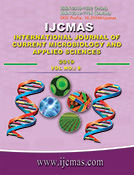


 National Academy of Agricultural Sciences (NAAS)
National Academy of Agricultural Sciences (NAAS)

|
PRINT ISSN : 2319-7692
Online ISSN : 2319-7706 Issues : 12 per year Publisher : Excellent Publishers Email : editorijcmas@gmail.com / submit@ijcmas.com Editor-in-chief: Dr.M.Prakash Index Copernicus ICV 2018: 95.39 NAAS RATING 2020: 5.38 |
Vermicompost is a nutrient-rich, microbiologically-active organic amendment that results from the interactions between earthworms and microorganisms during the breakdown of organic matter. It is a stabilized, finely divided peat-like material with a low C:N ratio, high porosity and high water-holding capacity, in which most nutrients are present in forms that are readily taken up by plants. Earthworms act as mechanical blenders, and by fragmenting the organic matter they modify its physical and chemical status by gradually reducing the ratio of C:N and increasing the surface area exposed to microorganisms - thus making it much more favourable for microbial activity and further decomposition. The use of compost in forestry and horticulture has occasionally been shown to be limited by the high electrical conductivity and the excessively high amount of certain ions that cause phytotoxicity, as a consequence of the chemical properties of the initial waste and /or inadequate composting procedures. These adverse effects, although possible, are less likely to occur when vermicompost is used as a potting amendment especially for raising forest nurseries. Production of high quality forest tree seedlings in nurseries is very important as far as tree nurseries and farmers are concerned for reversing the current degradation of natural forests, woodlands and scrublands. Quality seedling production is the main objective of forest nursery but the slow growth of seedlings limits the high quality seedling production. Readiness of seed to germinate for further multiplication is much warranted and there is a need to optimize a growing media for high quality seedling production in tree nurseries. Slow growing nature of seedlings is the major limiting factor for successful seedling production in tree nurseries which can be enhanced by standardizing the appropriate growing medium with the addition of quality vermicompost.
 |
 |
 |
 |
 |